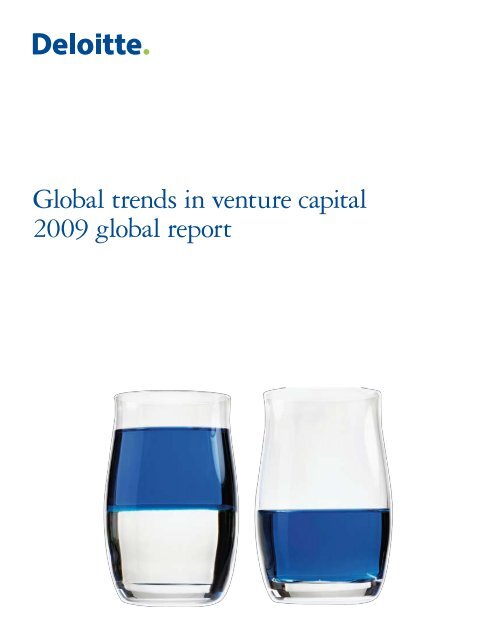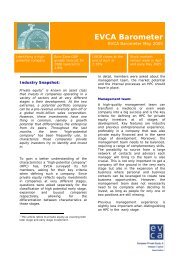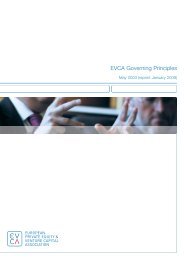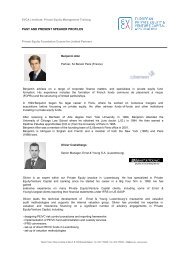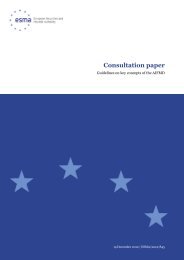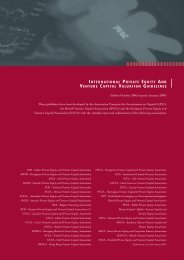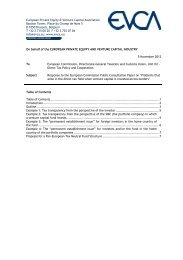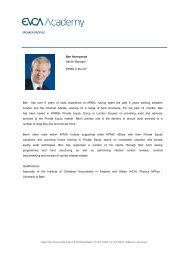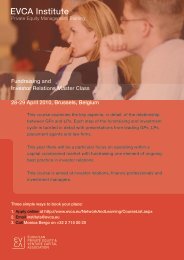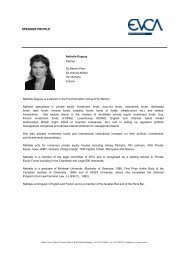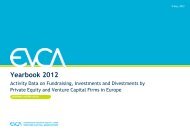Global trends in venture capital 2009 global report - Latin American ...
Global trends in venture capital 2009 global report - Latin American ...
Global trends in venture capital 2009 global report - Latin American ...
You also want an ePaper? Increase the reach of your titles
YUMPU automatically turns print PDFs into web optimized ePapers that Google loves.
<strong>Global</strong> <strong>trends</strong> <strong>in</strong> <strong>venture</strong> <strong>capital</strong><br />
<strong>2009</strong> <strong>global</strong> <strong>report</strong>
Contents<br />
1 Foreword<br />
2 About the survey<br />
4 Weather<strong>in</strong>g the storm: new strategies for new <strong>global</strong> economic conditions<br />
27 Appendix - A closer look<br />
33 Contacts<br />
Results analysis<br />
Deloitte Research-Survey Advisory Services <strong>in</strong> the United States and India used a variety of research and statistical tools to<br />
provide extensive analysis and <strong>in</strong>terpretation of the survey results. All charts with<strong>in</strong> this <strong>report</strong> are sourced from the survey<br />
results. Percentage labels <strong>in</strong> charts have been rounded and may not add to 100 percent.<br />
b
Foreword<br />
Are <strong>venture</strong> <strong>capital</strong>ists battl<strong>in</strong>g the <strong>global</strong> recession blues or feel<strong>in</strong>g optimistic about the new opportunities for <strong>in</strong>vest<strong>in</strong>g<br />
<strong>in</strong> technology? We wanted to know the answers to this question, as well as what is on the m<strong>in</strong>ds of <strong>venture</strong> <strong>capital</strong>ists<br />
around the world as they plan their future <strong>in</strong>vestment moves.<br />
The economic downturn is the f<strong>in</strong>ancial story of the year, so it was the obvious choice as the theme of the Deloitte Touche<br />
Tohmatsu (DTT) Technology, Media & Telecommunications (TMT) <strong>in</strong>dustry group’s <strong>2009</strong> <strong>Global</strong> Venture Capital Survey.<br />
Sponsored by the <strong>Global</strong> DTT TMT <strong>in</strong>dustry group, the survey was conducted <strong>in</strong> association with <strong>venture</strong> <strong>capital</strong> associations<br />
<strong>in</strong> the Americas, Asia Pacific, Europe and Israel.<br />
The <strong>2009</strong> survey marks the fifth anniversary of this project. As <strong>in</strong> past years, it was designed to offer <strong>in</strong>sights <strong>in</strong>to the<br />
attitudes and <strong>in</strong>tentions of <strong>venture</strong> <strong>capital</strong>ists around the globe regard<strong>in</strong>g specific geographic regions and <strong>in</strong>dustry sectors<br />
over the next five years.<br />
This year, we obviously hit a nerve; we received 725 responses—almost double the number compared to last year. The<br />
respondents are general partners of <strong>venture</strong> <strong>capital</strong> firms with assets under management rang<strong>in</strong>g from less than $100<br />
million to greater than $1 billion. Multiple responses from the same firm were allowed as the survey was a general<br />
measurement of the state of <strong>global</strong> <strong>in</strong>vest<strong>in</strong>g from general partners, not attitudes of specific firms. Of the total respondents,<br />
44 percent were based <strong>in</strong> the United States, 21 percent <strong>in</strong> Europe (exclud<strong>in</strong>g the UK), 16 percent <strong>in</strong> Asia Pacific, 10<br />
percent <strong>in</strong> the Americas (exclud<strong>in</strong>g the U.S.), 7 percent <strong>in</strong> the United K<strong>in</strong>gdom, and 2 percent <strong>in</strong> Israel.<br />
Those of us <strong>in</strong> the technology <strong>in</strong>dustry know that if you want to see the future, first look at what <strong>venture</strong> <strong>capital</strong>ists are<br />
th<strong>in</strong>k<strong>in</strong>g and do<strong>in</strong>g <strong>in</strong> the present. This year, it was important to learn how the economy was affect<strong>in</strong>g strategic decisions<br />
and how future <strong>in</strong>vestments were be<strong>in</strong>g planned—both by sector and region. Do <strong>venture</strong> <strong>capital</strong>ists anticipate that the<br />
size of their next funds will grow, shr<strong>in</strong>k or rema<strong>in</strong> the same? Who do they th<strong>in</strong>k their limited partners will be? What<br />
countries do they see as hav<strong>in</strong>g the most to ga<strong>in</strong> and lose <strong>in</strong> this new economy? What do they feel government should do<br />
to help spur <strong>in</strong>vestment <strong>in</strong> <strong>in</strong>novation?<br />
The responses of <strong>venture</strong> <strong>capital</strong>ists around the world were illum<strong>in</strong>at<strong>in</strong>g. And the good news is that you will f<strong>in</strong>d that while<br />
the <strong>in</strong>vestment community is com<strong>in</strong>g to grips with the hard realities of this <strong>global</strong> recession, they rema<strong>in</strong> a resilient group<br />
and even an optimistic one. You’ll learn which sectors they believe offer prime opportunities and what countries are the<br />
most <strong>in</strong>trigu<strong>in</strong>g to them. It’s been a tough season for <strong>in</strong>vestors and entrepreneurs alike, but that may have strengthened the<br />
<strong>in</strong>dustry. As Mark Heesen, president of the National Venture Capital Association (NVCA), said, “The tourists have left.”<br />
At a time when we are all mak<strong>in</strong>g critical decisions that impact the success of our bus<strong>in</strong>esses, I trust you will f<strong>in</strong>d the<br />
survey results both <strong>in</strong>sightful and useful.<br />
Jolyon Barker<br />
<strong>Global</strong> Manag<strong>in</strong>g Partner<br />
Deloitte Touche Tohmatsu<br />
Technology, Media & Telecommunications<br />
<strong>Global</strong> <strong>trends</strong> <strong>in</strong> <strong>venture</strong> <strong>capital</strong> <strong>2009</strong> <strong>global</strong> <strong>report</strong> 1
About the survey<br />
The <strong>2009</strong> <strong>Global</strong> Venture Capital Survey was sponsored by the <strong>Global</strong> DTT TMT <strong>in</strong>dustry group, <strong>in</strong> conjunction with the<br />
follow<strong>in</strong>g <strong>venture</strong> <strong>capital</strong> associations throughout the world:<br />
Brazilian Association of Private Equity & Venture Capital (ABVCAP)<br />
British Private Equity & Venture Capital Association (BVCA)<br />
Canada’s Venture Capital & Private Equity Association (CVCA)<br />
European Private Equity & Venture Capital Association (EVCA)<br />
Emerg<strong>in</strong>g Markets Private Equity Association (EMPEA)<br />
Indian Venture Capital Association (IVCA)<br />
Israel Venture Association (IVA)<br />
Lat<strong>in</strong> <strong>American</strong> Venture Capital Association (LAVCA)<br />
Malaysian Venture Capital and Private Equity Association (MVCA)<br />
National Venture Capital Association (NVCA)<br />
S<strong>in</strong>gapore Venture Capital & Private Equity Association (SVCA)<br />
Taiwan Private Equity & Venture Capital Association (TVCA)<br />
Zero2IPO<br />
The survey was conducted with <strong>venture</strong> <strong>capital</strong>ists (VCs) <strong>in</strong> the Americas, Asia Pacific (AP), Europe and Israel. There were<br />
725 responses from general partners of <strong>venture</strong> <strong>capital</strong> firms with assets under management rang<strong>in</strong>g from less than $100<br />
million 1 to greater than $1 billion.<br />
Multiple responses from the same firm were allowed, as the survey was a general measurement of the state of <strong>global</strong><br />
<strong>in</strong>vest<strong>in</strong>g from all general partners, not attitudes of specific firms. If respondents did not answer a question, the count for<br />
the question was adjusted accord<strong>in</strong>gly.<br />
The highest number of respondents—35 percent—claimed assets under management total<strong>in</strong>g between $100 million and<br />
$499 million. Another 34 percent had managed assets that were less than $100 million, 17 percent had managed assets<br />
greater than $1 billion, and 14 percent had between $500 million and $1 billion <strong>in</strong> assets under management.<br />
Assets under management<br />
40%<br />
35%<br />
35%<br />
30%<br />
25%<br />
20%<br />
15%<br />
18%<br />
16%<br />
14%<br />
17%<br />
10%<br />
5%<br />
0%<br />
$1 - $49 million<br />
$50 - $99 million<br />
$100 - $499 million<br />
$500 million - $1 billion<br />
> $1 billion<br />
1 All references to currency are <strong>in</strong> U.S. dollars, unless otherwise noted.<br />
2
Geographically, the breakdown of responses cont<strong>in</strong>ues to be fairly representative of both the size and location of firms<br />
<strong>in</strong> the <strong>venture</strong> <strong>capital</strong> <strong>in</strong>dustry around the world. Forty-four percent of the respondents were from the United States, 21<br />
percent from European countries (exclud<strong>in</strong>g the UK), 16 percent from Asia Pacific countries, 10 percent from the Americas<br />
(exclud<strong>in</strong>g the U.S.), 7 percent from the UK, and 2 percent from Israel.<br />
Location of respondents<br />
Firm type<br />
7%<br />
16%<br />
28%<br />
AP<br />
Europe (excl. UK)<br />
Israel<br />
44%<br />
21%<br />
the Americas (excl. U.S.)<br />
U.S.<br />
UK<br />
72%<br />
10%<br />
2%<br />
Venture Capital<br />
Private Equity and Venture Capital<br />
Seventy-two percent of the respondents had a primary <strong>in</strong>vestment focus on <strong>venture</strong> <strong>capital</strong> while 28 percent were<br />
primarily focused on private equity and <strong>venture</strong> <strong>capital</strong>. And, this year, 52 percent of <strong>venture</strong> <strong>capital</strong>ists noted that they are<br />
<strong>in</strong>vest<strong>in</strong>g outside of their home country.<br />
Given the severity of the current <strong>global</strong> recession, this year’s survey focused on issues surround<strong>in</strong>g its impact on <strong>venture</strong><br />
<strong>capital</strong>ists. The survey questions asked how the <strong>global</strong> recession is affect<strong>in</strong>g strategy; how future <strong>in</strong>vestments are be<strong>in</strong>g<br />
planned, both by sector and region; what the anticipated size of the next fund will be and who VCs th<strong>in</strong>k their limited<br />
partners will be. We also wanted to know what countries they believe have the most to ga<strong>in</strong> and lose <strong>in</strong> this new<br />
economy, as well as what they feel the role of government should be <strong>in</strong> foster<strong>in</strong>g <strong>in</strong>novation.<br />
This year’s <strong>report</strong> looks broadly at the results <strong>in</strong> a <strong>global</strong> context, but an appendix is <strong>in</strong>cluded that breaks out survey<br />
responses by geographic regions—the U.S., the Americas (exclud<strong>in</strong>g the U.S.) Europe (exclud<strong>in</strong>g the UK), UK, AP and<br />
Israel. If you are <strong>in</strong>terested <strong>in</strong> responses of <strong>in</strong>vestors <strong>in</strong> a specific region, we encourage you to check the appendix for<br />
those charts.<br />
<strong>Global</strong> <strong>trends</strong> <strong>in</strong> <strong>venture</strong> <strong>capital</strong> <strong>2009</strong> <strong>global</strong> <strong>report</strong> 3
Weather<strong>in</strong>g the storm:<br />
new strategies for new <strong>global</strong><br />
economic conditions<br />
“The perfect storm” has become the cliché of choice to sum up the <strong>global</strong> economic recession of 2008-<strong>2009</strong>. Certa<strong>in</strong>ly,<br />
today’s economic environment is dramatically different than the one <strong>venture</strong> <strong>capital</strong>ists were operat<strong>in</strong>g <strong>in</strong> five years ago<br />
when the first <strong>Global</strong> Venture Capital Survey was launched. Five years ago, the <strong>venture</strong> <strong>capital</strong> community was recover<strong>in</strong>g<br />
from the tech bubble burst<strong>in</strong>g and was just beg<strong>in</strong>n<strong>in</strong>g to see significant move towards the <strong>global</strong>ization of the <strong>venture</strong><br />
<strong>capital</strong> <strong>in</strong>dustry.<br />
Today, the economy is <strong>in</strong> a far different place. But, there are still signs of optimism. VCs are more attuned to the <strong>global</strong><br />
economy and we’re see<strong>in</strong>g the maturation of some sectors—specifically semiconductors and telecom—while other<br />
sectors—clean technologies and life sciences—are emerg<strong>in</strong>g as areas with great growth potential. With this shake up <strong>in</strong><br />
the economy, we are see<strong>in</strong>g <strong>venture</strong> <strong>capital</strong>ists make adjustments to their <strong>in</strong>vestment strategy <strong>in</strong> order to weather this<br />
storm and establish the foundation to thrive <strong>in</strong> the future.<br />
“It’s been a difficult recession, but the <strong>in</strong>dustry is cop<strong>in</strong>g and mak<strong>in</strong>g adjustments,” said Mark Jensen, U.S. national<br />
manag<strong>in</strong>g partner of Deloitte and Touche LLP’s Venture Capital Services. “They’re mov<strong>in</strong>g forward and not sitt<strong>in</strong>g on their<br />
hands wait<strong>in</strong>g for someth<strong>in</strong>g to happen.”<br />
In general, VCs are decreas<strong>in</strong>g their overall <strong>in</strong>vest<strong>in</strong>g dollars, focus<strong>in</strong>g on their best companies and <strong>in</strong>creas<strong>in</strong>g their allocation<br />
to later-stage <strong>in</strong>vestments.<br />
“We have not altered our fundamental strategic focus on early-stage health care <strong>in</strong>vest<strong>in</strong>g <strong>in</strong> response to the recession,”<br />
expla<strong>in</strong>ed Kev<strong>in</strong> Lalande, manag<strong>in</strong>g director of Sante Ventures. “That said, new market realities and l<strong>in</strong>ger<strong>in</strong>g uncerta<strong>in</strong>ty<br />
have factored prom<strong>in</strong>ently <strong>in</strong> our decisions about which specific opportunities to pursue of those consistent with our<br />
strategy. In the current environment, we are opt<strong>in</strong>g for fewer, more <strong>capital</strong> efficient deals <strong>in</strong> which the exist<strong>in</strong>g <strong>venture</strong><br />
syndicate has enough reserve capacity to fund a company, if necessary, all the way to cash flow <strong>in</strong>dependence.”<br />
Adjust<strong>in</strong>g to a New Reality<br />
In short, the tourists have left, expla<strong>in</strong>ed Mark Heesen, president of the NVCA. “Young entrepreneurs who thought they<br />
could get rich quickly with just a good idea are now gone and those now left stand<strong>in</strong>g recognize the challenges and<br />
tenacity needed to establish and build a susta<strong>in</strong>able bus<strong>in</strong>ess,” he said. “Those out on the hust<strong>in</strong>gs try<strong>in</strong>g to get funded<br />
are much more astute about the <strong>global</strong>ization of the economy and worldwide competition. They understand that the<br />
value of their company today is not what it will be six months from now and that if they want to be funded, it will likely<br />
be at a lower valuation than <strong>in</strong> the past.”<br />
Lower valuations could present opportunities for VCs look<strong>in</strong>g for a good deal. But are they spend<strong>in</strong>g? In fact, we see the<br />
larger firms ey<strong>in</strong>g a bigger slowdown than the smaller firms. Just more than half of respondents from firms manag<strong>in</strong>g<br />
$500 million or more are decreas<strong>in</strong>g their level of <strong>in</strong>vestment, compared to about one <strong>in</strong> three of those manag<strong>in</strong>g $99<br />
million or less.<br />
4
Impact of the <strong>global</strong> recession on <strong>in</strong>vestment strategies – level of <strong>in</strong>vestment <strong>in</strong> terms of <strong>capital</strong><br />
(by assets under management)<br />
100%<br />
17%<br />
21%<br />
18%<br />
12% 13%<br />
80%<br />
37% 36%<br />
60%<br />
49%<br />
47%<br />
42%<br />
40%<br />
20%<br />
34% 32%<br />
40%<br />
51% 51%<br />
0%<br />
$1 - $49 million<br />
$50 - $99 million<br />
$100 - $499 million<br />
$500 million - $1 billion<br />
> $1 billion<br />
Increas<strong>in</strong>g level of <strong>in</strong>vestment Same level of <strong>in</strong>vestment Decreas<strong>in</strong>g level of <strong>in</strong>vestment<br />
However, the vast majority of firms are ma<strong>in</strong>ta<strong>in</strong><strong>in</strong>g the same strategy when it comes to <strong>in</strong>dustry sector. At least seven<br />
out of 10 VCs—and the percentage <strong>in</strong>creases with the size of the firm—plan to ma<strong>in</strong>ta<strong>in</strong> the same strategy <strong>in</strong> terms of<br />
<strong>in</strong>dustry sector.<br />
Impact of the <strong>global</strong> recession on <strong>in</strong>vestment strategies – <strong>in</strong>dustry sector (by assets under management)<br />
100%<br />
80%<br />
27% 26%<br />
18% 18% 17%<br />
60%<br />
40%<br />
73% 74%<br />
82% 82% 83%<br />
20%<br />
0%<br />
$1 - $49 million<br />
$50 - $99 million<br />
$100 - $499 million<br />
$500 million - $1 billion<br />
> $1 billion<br />
Ma<strong>in</strong>ta<strong>in</strong><strong>in</strong>g same strategy <strong>in</strong> terms of <strong>in</strong>dustry sector<br />
Chang<strong>in</strong>g strategy <strong>in</strong> terms of <strong>in</strong>dustry sector<br />
“Our firm is <strong>in</strong>terested primarily <strong>in</strong> potentially great companies that already have some revenue traction,” said Patrick<br />
Sheehan, a partner with Environmental Technologies Fund. “We’re try<strong>in</strong>g to f<strong>in</strong>d situations where we understand<br />
customer need, and it’s easier to do when there are exist<strong>in</strong>g customers. Our <strong>in</strong>vest<strong>in</strong>g style hasn’t changed with the<br />
recession; it’s become more appropriate.”<br />
<strong>Global</strong> <strong>trends</strong> <strong>in</strong> <strong>venture</strong> <strong>capital</strong> <strong>2009</strong> <strong>global</strong> <strong>report</strong> 5
What VCs are re-evaluat<strong>in</strong>g is the stage <strong>in</strong> which they’re <strong>in</strong>vest<strong>in</strong>g. Very few are shift<strong>in</strong>g to early-stage <strong>in</strong>vest<strong>in</strong>g. Instead,<br />
about half are ma<strong>in</strong>ta<strong>in</strong><strong>in</strong>g their current strategy and a significant percentage are shift<strong>in</strong>g their focus to later-stage and<br />
exist<strong>in</strong>g portfolio companies. No doubt this is due to both the stra<strong>in</strong> on the <strong>capital</strong> markets and the fact that it’s now<br />
tak<strong>in</strong>g longer for companies to be acquired and rare for them to go public. Invest<strong>in</strong>g <strong>in</strong> later-stage companies shortens<br />
the VC’s gestation period and allows them to exit sooner.<br />
“In this environment, it pays to be either a very early-stage <strong>in</strong>vestor or a very late-stage <strong>in</strong>vestor,” said Steve Fredrick, general<br />
partner of Grotech Ventures. “The classic Series B round, where a bus<strong>in</strong>ess is still f<strong>in</strong>d<strong>in</strong>g its legs and rema<strong>in</strong><strong>in</strong>g <strong>capital</strong><br />
requirements are at best an estimate, carries more risk given higher burn rates and the climate’s uncerta<strong>in</strong>ty around future<br />
f<strong>in</strong>anc<strong>in</strong>gs. So, we’re see<strong>in</strong>g reduced <strong>in</strong>vestment levels as firms either <strong>in</strong>vest smaller sums <strong>in</strong> very early-stage companies, or<br />
<strong>in</strong>vest traditional sums <strong>in</strong> fewer and much later-stage companies. The middle ground has been largely vacated.”<br />
Impact of the <strong>global</strong> recession on <strong>in</strong>vestment strategies – stage (by assets under management)<br />
100%<br />
8% 5% 7% 4% 2%<br />
80%<br />
60%<br />
58% 65% 58%<br />
57%<br />
54%<br />
40%<br />
20%<br />
34% 30%<br />
35%<br />
39%<br />
44%<br />
0%<br />
$1 - $49 million<br />
$50 - $99 million<br />
$100 - $499 million<br />
$500 million - $1 billion<br />
> $1 billion<br />
Shift<strong>in</strong>g focus to later-stage companies<br />
and exist<strong>in</strong>g portfolio companies<br />
Ma<strong>in</strong>ta<strong>in</strong><strong>in</strong>g current strategy<br />
<strong>in</strong> terms of stage<br />
Shift<strong>in</strong>g focus to<br />
early-stage companies<br />
Five years ago, when the first <strong>Global</strong> Venture Capital Survey was conducted, the results <strong>in</strong>dicated some <strong>in</strong>terest <strong>in</strong> clean<br />
technologies and the life sciences. This year, regardless of fund size, we see tremendous <strong>in</strong>terest from VCs <strong>in</strong> both of these<br />
sectors, especially clean technologies, where more than six out of 10 respondents anticipate their <strong>in</strong>vestment levels to<br />
<strong>in</strong>crease and another three out of 10 will hold their <strong>in</strong>vestments at the same level.<br />
6
In terms of total <strong>capital</strong> <strong>in</strong>vested, anticipated level of <strong>in</strong>vestment change <strong>in</strong> select sectors,<br />
over the next three years<br />
Telecommunications<br />
Semiconductors, <strong>in</strong>clud<strong>in</strong>g electronics<br />
Software<br />
New media/social network<strong>in</strong>g<br />
Biopharmaceuticals<br />
Medical device and equipment<br />
Clean technologies<br />
Consumer bus<strong>in</strong>ess<br />
15% 56% 29%<br />
6% 44% 50%<br />
22% 60% 18%<br />
26% 49% 25%<br />
24% 48% 28%<br />
37% 51% 12%<br />
63% 32% 6%<br />
24% 51% 25%<br />
0% 20% 40% 60% 80% 100%<br />
Increase<br />
Rema<strong>in</strong> the same<br />
Decrease<br />
Among U.S., UK and Israeli <strong>in</strong>vestors, about half expect to <strong>in</strong>crease their <strong>in</strong>vestments <strong>in</strong> cleantech, while about seven out<br />
of 10 AP respondents and European respondents expect their cleantech <strong>in</strong>vestments to <strong>in</strong>crease. Two-thirds of respondents<br />
from the Americas plan to <strong>in</strong>crease their cleantech <strong>in</strong>vestments. This <strong>in</strong>terest could be because we’re see<strong>in</strong>g an<br />
<strong>in</strong>crease <strong>in</strong> government/political support for cleantech and VCs are look<strong>in</strong>g more to government participation <strong>in</strong> both<br />
<strong>in</strong>vestments and <strong>in</strong>centives.<br />
In terms of total <strong>capital</strong> <strong>in</strong>vested, anticipated level of <strong>in</strong>vestment change <strong>in</strong> clean technologies,<br />
over the next three years (by location)<br />
AP<br />
73% 24% 3%<br />
Europe (excl. UK)<br />
71% 24% 5%<br />
Israel<br />
50% 50%<br />
the Americas (excl. U.S.)<br />
66% 28% 7%<br />
U.S.<br />
55% 38% 7%<br />
UK<br />
50% 43% 7%<br />
0% 20% 40% 60% 80% 100%<br />
Increase<br />
Rema<strong>in</strong> the same<br />
Decrease<br />
<strong>Global</strong> <strong>trends</strong> <strong>in</strong> <strong>venture</strong> <strong>capital</strong> <strong>2009</strong> <strong>global</strong> <strong>report</strong> 7
“Governments around the world are very supportive of creat<strong>in</strong>g a cleantech <strong>in</strong>dustry with tax credits and <strong>in</strong>centives,” said<br />
Heesen. “In the U.S., it’s now seen as an energy <strong>in</strong>dependence issue, a security issue and a jobs issue. And the public is<br />
more supportive of cleantech activities as more people are cognizant of the threat of <strong>global</strong> warm<strong>in</strong>g.”<br />
But while this f<strong>in</strong>d<strong>in</strong>g is significant, it’s also important to note that with a couple of exceptions where the sectors have<br />
significantly matured—semiconductors and telecommunications—VCs expect their level of <strong>in</strong>vestment <strong>in</strong> other <strong>in</strong>dustries<br />
to rema<strong>in</strong> the same or <strong>in</strong>crease.<br />
Eastern Exposure<br />
Another trend that hasn’t changed <strong>in</strong> the last five years is <strong>venture</strong> <strong>capital</strong>ists’ <strong>in</strong>terest <strong>in</strong> Ch<strong>in</strong>a and India. Regardless of the<br />
size of the firm, <strong>in</strong>vestors are <strong>in</strong>trigued by the <strong>in</strong>vestment possibilities of these two countries.<br />
“We are lucky to be sitt<strong>in</strong>g at the hub of what we believe will be the most excit<strong>in</strong>g <strong>venture</strong> market <strong>in</strong> the com<strong>in</strong>g years—<br />
Ch<strong>in</strong>a,” said Gav<strong>in</strong> Ni, founder, president and CEO of Zero2IPO. “If you take a look at the short-term, you see Ch<strong>in</strong>a will be<br />
the first to emerge out of the worldwide downturn. Ch<strong>in</strong>a is project<strong>in</strong>g 7 percent-plus GDP growth <strong>in</strong> <strong>2009</strong>—the highest<br />
<strong>in</strong> the world. Then, look<strong>in</strong>g beyond, you see a swell<strong>in</strong>g middle class—but still a m<strong>in</strong>ority of the population—with money<br />
<strong>in</strong> their pockets to spend. That does not even scratch the surface of the eventual buy<strong>in</strong>g power of the largest population<br />
<strong>in</strong> the world—1.3 billion potential consumers.”<br />
Half of all respondents expect their <strong>in</strong>vestment levels to <strong>in</strong>crease <strong>in</strong> Asia (exclud<strong>in</strong>g India), while 43 percent expect to<br />
<strong>in</strong>crease their <strong>in</strong>vestments <strong>in</strong> India over the next three years. In 2007, 41 percent of respondents <strong>in</strong>dicated an <strong>in</strong>terest<br />
<strong>in</strong> expand<strong>in</strong>g their <strong>in</strong>vestment focus <strong>in</strong> Asia Pacific. About one-third expect to <strong>in</strong>crease their <strong>in</strong>vestment levels <strong>in</strong> South<br />
America. Only 17 percent expect to <strong>in</strong>crease their <strong>in</strong>vestments <strong>in</strong> North America, the same as 2007.<br />
Compared to North America, the numbers were only slightly better for Europe and the UK (25 percent) and Israel (19<br />
percent). More than half of the respondents do <strong>in</strong>tend to ma<strong>in</strong>ta<strong>in</strong> their <strong>in</strong>vestment levels <strong>in</strong> Europe, while 21 percent<br />
expect those levels to decrease. This <strong>in</strong>vestment strategy is a change from 2007, when one-third of respondents <strong>in</strong>dicated<br />
that they were <strong>in</strong>terested <strong>in</strong> expand<strong>in</strong>g their <strong>in</strong>vestment focus <strong>in</strong> Europe.<br />
“We are lucky to be sitt<strong>in</strong>g at the hub of what<br />
we believe will be the most excit<strong>in</strong>g <strong>venture</strong><br />
market <strong>in</strong> the com<strong>in</strong>g years—Ch<strong>in</strong>a.”<br />
8
In terms of total <strong>capital</strong> <strong>in</strong>vested, anticipated level of <strong>in</strong>vestment change <strong>in</strong> select regions,<br />
over the next three years<br />
Asia (excl. India)<br />
50% 38% 12%<br />
Europe and the UK<br />
25% 54% 21%<br />
India<br />
43% 47% 11%<br />
Israel<br />
19% 62% 19%<br />
North America<br />
17% 60% 22%<br />
South America<br />
36% 45% 19%<br />
0% 20% 40% 60% 80% 100%<br />
Increase<br />
Rema<strong>in</strong> the same<br />
Decrease<br />
When it comes to <strong>in</strong>terest <strong>in</strong> Asia and India, UK respondents are the most enthusiastic, plann<strong>in</strong>g either to <strong>in</strong>crease <strong>in</strong>vestment<br />
levels (67 percent and 58 percent, respectively) or keep them at the same levels (33 percent and 42 percent, respectively).<br />
But, about n<strong>in</strong>e out of 10 U.S. VCs are also <strong>in</strong>creas<strong>in</strong>g or ma<strong>in</strong>ta<strong>in</strong><strong>in</strong>g their <strong>in</strong>vestments <strong>in</strong> Asia and India, and about<br />
the same number of respondents from Asia Pacific have similar plans.<br />
In terms of total <strong>capital</strong> <strong>in</strong>vested, anticipated level of <strong>in</strong>vestment change <strong>in</strong> Asia Pacific (excl. India),<br />
over the next three years (by location)<br />
AP<br />
61% 29% 11%<br />
Europe (excl. UK)<br />
52% 28% 20%<br />
Israel<br />
67% 33%<br />
the Americas (excl. U.S.)<br />
46% 38% 15%<br />
U.S.<br />
40% 50% 11%<br />
UK<br />
67% 33%<br />
0% 20% 40% 60% 80% 100%<br />
Increase<br />
Rema<strong>in</strong> the same<br />
Decrease<br />
<strong>Global</strong> <strong>trends</strong> <strong>in</strong> <strong>venture</strong> <strong>capital</strong> <strong>2009</strong> <strong>global</strong> <strong>report</strong> 9
In terms of total <strong>capital</strong> <strong>in</strong>vested, anticipated level of <strong>in</strong>vestment change <strong>in</strong> India, over the next<br />
three years (by location)<br />
AP<br />
57% 36% 7%<br />
Europe (excl. UK)<br />
38% 48% 14%<br />
Israel<br />
83% 17%<br />
the Americas (excl. U.S.)<br />
46% 31% 23%<br />
U.S.<br />
34% 55% 12%<br />
UK<br />
58% 42%<br />
0% 20% 40% 60% 80% 100%<br />
Increase<br />
Rema<strong>in</strong> the same<br />
Decrease<br />
In other words, noted Jensen, “Firms are now look<strong>in</strong>g at the whole world <strong>in</strong> terms of their <strong>in</strong>vest<strong>in</strong>g priorities. The world<br />
has gone <strong>global</strong> <strong>in</strong> <strong>venture</strong> <strong>capital</strong> and the firms are adapt<strong>in</strong>g their strategies accord<strong>in</strong>gly.”<br />
David Chao, co-founder and general partner of DCM, agrees. “The l<strong>in</strong>es between whether a company is <strong>American</strong>,<br />
Asian or European are blurr<strong>in</strong>g because by necessity many start-ups today have multiple offices. Entrepreneurs can start<br />
companies anywhere they want <strong>in</strong> the world and pick locations where conditions are favorable and talent pools are<br />
available at reasonable prices.”<br />
That perspective is re<strong>in</strong>forced when you see that <strong>in</strong>vestment <strong>in</strong>terest <strong>in</strong> North America seems to be decreas<strong>in</strong>g. Only 29<br />
percent of VCs <strong>in</strong> the Americas (exclud<strong>in</strong>g the U.S.) plan to <strong>in</strong>crease their <strong>in</strong>vestments <strong>in</strong> North <strong>American</strong> countries while<br />
37 percent expect them to rema<strong>in</strong> the same. Twenty-two percent of Israeli <strong>in</strong>vestors plan to <strong>in</strong>crease their North <strong>American</strong><br />
<strong>in</strong>vestments while 33 percent expect <strong>in</strong>vestment levels to rema<strong>in</strong> the same. European <strong>in</strong>vestors (exclud<strong>in</strong>g the UK) are<br />
look<strong>in</strong>g at a 16 percent <strong>in</strong>crease and half expect their <strong>in</strong>vestments to rema<strong>in</strong> the same. Only 15 percent of Asia Pacific VCs<br />
expect to <strong>in</strong>crease their <strong>in</strong>vestment <strong>in</strong> North <strong>American</strong> countries while 40 percent expect it to rema<strong>in</strong> the same. In the UK,<br />
a mere 14 percent plan on <strong>in</strong>creas<strong>in</strong>g their <strong>in</strong>vestments but 48 percent plan on keep<strong>in</strong>g their levels the same. Even among<br />
U.S. VCs, only 16 percent plan to <strong>in</strong>crease their North <strong>American</strong> <strong>in</strong>vest<strong>in</strong>g levels while 71 percent expect their <strong>in</strong>vestment<br />
levels to stay as they are.<br />
“The l<strong>in</strong>es between whether a company is<br />
<strong>American</strong>, Asian or European are blurr<strong>in</strong>g...”<br />
10
In terms of total <strong>capital</strong> <strong>in</strong>vested, anticipated level of <strong>in</strong>vestment change <strong>in</strong> North America,<br />
over the next three years (by location)<br />
AP<br />
15% 40% 45%<br />
Europe (excl. UK)<br />
16% 50% 34%<br />
Israel<br />
22% 33% 44%<br />
the Americas (excl. U.S.)<br />
29% 37% 33%<br />
U.S.<br />
16% 71% 13%<br />
UK<br />
14% 48% 38%<br />
0% 20% 40% 60% 80% 100%<br />
Increase<br />
Rema<strong>in</strong> the same<br />
Decrease<br />
Why is there so much <strong>in</strong>terest <strong>in</strong> Ch<strong>in</strong>a and India? Ch<strong>in</strong>a and India are emerg<strong>in</strong>g markets compared to North America,<br />
and the U.S. specifically, with great growth potential. Also, the stra<strong>in</strong>ed exit markets <strong>in</strong> the U.S. and the impact of recent<br />
government policies appear to be discourag<strong>in</strong>g <strong>in</strong>vestors from <strong>in</strong>creas<strong>in</strong>g their risk exposure <strong>in</strong> North America.<br />
Venture <strong>capital</strong>ists anticipated level of <strong>in</strong>vestment <strong>in</strong> Europe and the UK, over the next three years (by location)<br />
AP<br />
9% 29% 63%<br />
Europe (excl. UK)<br />
26% 64% 10%<br />
Israel<br />
57% 43%<br />
the Americas (excl. U.S.)<br />
43% 14% 43%<br />
U.S.<br />
28% 52% 20%<br />
UK<br />
22% 57% 20%<br />
0% 20% 40% 60% 80% 100%<br />
Increase<br />
Rema<strong>in</strong> the same<br />
Decrease<br />
At least a quarter of <strong>global</strong> VCs <strong>in</strong>tend to <strong>in</strong>crease their <strong>in</strong>vestments levels <strong>in</strong> Europe and the UK. This is ma<strong>in</strong>ly driven by<br />
VCs <strong>in</strong> the Americas (exclud<strong>in</strong>g the U.S.), among which 43 percent plan to <strong>in</strong>vest more <strong>in</strong>to Europe and the UK. However,<br />
another 43 percent of the VCs <strong>in</strong> that same area <strong>in</strong>tend to reduce their <strong>in</strong>vestments <strong>in</strong> Europe and the UK. The most<br />
<strong>Global</strong> <strong>trends</strong> <strong>in</strong> <strong>venture</strong> <strong>capital</strong> <strong>2009</strong> <strong>global</strong> <strong>report</strong> 11
positive forecast comes from U.S. players, among which 28% expect to <strong>in</strong>crease <strong>in</strong>vestments, while only 20% foresee a<br />
decrease. Israeli and Asia-Pacific VCs show the least <strong>in</strong>terest <strong>in</strong> Europe and the UK.<br />
Fund Rais<strong>in</strong>g<br />
Despite the fact that the world is struggl<strong>in</strong>g with a recession, VCs are remarkably optimistic about their future funds. Most<br />
VCs believe that their next fund will be either larger than their exist<strong>in</strong>g fund or will be approximately the same size. And,<br />
that’s across the board, regardless of the size of the <strong>venture</strong> firm or where they’re located.<br />
Among those manag<strong>in</strong>g more than $1 billion, 24 percent project that their next fund size will <strong>in</strong>crease while almost half<br />
expect it to rema<strong>in</strong> the same. Less than a third anticipate a decrease. Those numbers are very close when it comes to<br />
those firms manag<strong>in</strong>g $500 million to $1 billion. As the size of the firm grows smaller, the firms grow more optimistic<br />
about the size of their next fund levels, with 60 percent of the smallest—those manag<strong>in</strong>g $1 million to $49 million—<br />
anticipat<strong>in</strong>g their fund levels will grow and another 28 percent stat<strong>in</strong>g that they’ll rema<strong>in</strong> the same.<br />
Projected fund size compared to current fund (by assets under management)<br />
100%<br />
12% 13%<br />
19% 22%<br />
80%<br />
28% 29%<br />
33%<br />
28%<br />
60%<br />
51% 48%<br />
40%<br />
20%<br />
60% 58%<br />
49%<br />
27% 24%<br />
0%<br />
$1 - $49 million<br />
$50 - $99 million<br />
$100 - $499 million<br />
$500 million - $1 billion<br />
> $1 billion<br />
Increase<br />
Rema<strong>in</strong> the same<br />
Decrease<br />
The numbers are far more consistent when you look at this question regionally. Very little decrease <strong>in</strong> fund size is projected<br />
across the board. And, those project<strong>in</strong>g <strong>in</strong>creases or stasis range from the Americas (exclud<strong>in</strong>g the U.S.) at 73 percent to<br />
the UK at 87 percent. The region anticipat<strong>in</strong>g the greatest <strong>in</strong>crease <strong>in</strong> their next fund is Europe (exclud<strong>in</strong>g the UK) at 55<br />
percent. Europe (exclud<strong>in</strong>g the UK) (15 percent) and the UK (13 percent) are the regions with the lowest expectations of<br />
decreased fund size <strong>in</strong> the future.<br />
12
Projected fund size compared to current fund (by location)<br />
100%<br />
21%<br />
15%<br />
21%<br />
27%<br />
18%<br />
13%<br />
19%<br />
80%<br />
60%<br />
30%<br />
30%<br />
43%<br />
23%<br />
43%<br />
44%<br />
37%<br />
40%<br />
20%<br />
49% 55%<br />
36% 50% 38% 43%<br />
45%<br />
0%<br />
AP<br />
Europe (excl. UK)<br />
Israel<br />
the Americas (excl. U.S.)<br />
U.S.<br />
UK<br />
Increase<br />
Rema<strong>in</strong> the same<br />
Decrease<br />
Where around the world is this money com<strong>in</strong>g from? Over the next five years, the vast number of respondents expect<br />
that the number of their limited partner <strong>in</strong>vestors located outside their home country or region will rema<strong>in</strong> the same<br />
or <strong>in</strong>crease, aga<strong>in</strong> regardless of the size of the firm or their home country. UK <strong>in</strong>vestors, at 97 percent, appear to be<br />
the most eager to engage <strong>in</strong>vestors outside of their home country, but even 92 percent of those VCs respond<strong>in</strong>g from<br />
Europe (exclud<strong>in</strong>g the UK) project that the number of their limited partners located outside of their region will rema<strong>in</strong><br />
the same or <strong>in</strong>crease.<br />
Anticipated number of <strong>in</strong>vestors (Limited Partners) located outside the <strong>venture</strong> <strong>capital</strong>ists home<br />
country/region, over the next five years (by location)<br />
100%<br />
15%<br />
8%<br />
14%<br />
9%<br />
5% 4%<br />
8%<br />
80%<br />
60%<br />
31%<br />
32%<br />
64%<br />
30%<br />
43% 43%<br />
38%<br />
40%<br />
20%<br />
54%<br />
60%<br />
21%<br />
61%<br />
52% 54%<br />
54%<br />
0%<br />
AP<br />
Europe (excl. UK)<br />
Israel<br />
the Americas (excl. U.S.)<br />
U.S.<br />
UK<br />
Increase<br />
Rema<strong>in</strong> the same<br />
Decrease<br />
<strong>Global</strong> <strong>trends</strong> <strong>in</strong> <strong>venture</strong> <strong>capital</strong> <strong>2009</strong> <strong>global</strong> <strong>report</strong> 13
There is, however, a disconnect between the optimism these respondents expressed and where the <strong>in</strong>vestment funds will<br />
actually come from. We asked <strong>venture</strong> <strong>capital</strong>ists how the current economic crisis will affect the various types of limited<br />
partners’ will<strong>in</strong>gness to <strong>in</strong>vest over the next three years, and while they plan to <strong>in</strong>crease the size of their funds and level of<br />
<strong>in</strong>vest<strong>in</strong>g, they nevertheless see their traditional <strong>in</strong>vestor base—commercial banks, <strong>in</strong>vestment banks, corporate operat<strong>in</strong>g<br />
funds, <strong>in</strong>surance companies and public pension funds—to be dry<strong>in</strong>g up.<br />
“Limited partners were cutt<strong>in</strong>g their <strong>venture</strong> allocations and number of managers before this economic period began.<br />
Like all good <strong>in</strong>vestors, they are track<strong>in</strong>g results and cull<strong>in</strong>g their herd. While they may have taken more risks <strong>in</strong> years<br />
past to <strong>in</strong>crease their dollars or number of <strong>in</strong>vestments, no doubt the jury is start<strong>in</strong>g to come <strong>in</strong>,” expla<strong>in</strong>ed Ray Rothrock,<br />
manag<strong>in</strong>g general partner at Venrock. “However, <strong>venture</strong> is still popular for LPs, if they can f<strong>in</strong>d the right groups. I would<br />
th<strong>in</strong>k they, like VCs seek<strong>in</strong>g great entrepreneurs everywhere, are seek<strong>in</strong>g great VCs everywhere. It makes perfect sense.”<br />
Among all respondents, 88 percent see commercial bank <strong>in</strong>vestors’ will<strong>in</strong>gness to <strong>in</strong>vest <strong>in</strong> <strong>venture</strong> <strong>capital</strong> over the next<br />
three years decreas<strong>in</strong>g. Another 87 percent were just as pessimistic over <strong>in</strong>vestment banks. About six out of 10 were not<br />
sangu<strong>in</strong>e about corporate operat<strong>in</strong>g funds, <strong>in</strong>surance companies, corporate <strong>venture</strong> <strong>capital</strong>, and endowments decreas<strong>in</strong>g<br />
as limited partners.<br />
Intrigu<strong>in</strong>gly, <strong>venture</strong> <strong>capital</strong>ists are look<strong>in</strong>g to governments as their f<strong>in</strong>ancial partners. More than half of VCs see an<br />
<strong>in</strong>crease <strong>in</strong> governments as will<strong>in</strong>g <strong>in</strong>vestment partners with another fourth look<strong>in</strong>g at an <strong>in</strong>crease by family offices.<br />
The current economic crisis will affect the follow<strong>in</strong>g types of limited partners' will<strong>in</strong>gness to <strong>in</strong>vest <strong>in</strong> the<br />
<strong>venture</strong> <strong>capital</strong> asset class, over the next three years<br />
Commercial banks 4% 8% 88%<br />
Investment banks 4% 8% 87%<br />
Corporate operat<strong>in</strong>g funds 15% 22% 63%<br />
Corporate <strong>venture</strong> <strong>capital</strong> 23% 29% 48%<br />
Endowments 9% 32% 59%<br />
Family offices<br />
23% 31% 47%<br />
Foundations 14% 30% 56%<br />
Fund of funds 22% 38% 40%<br />
Governments<br />
54% 21% 24%<br />
Individuals and families 19% 24% 57%<br />
Insurance companies 9% 26% 65%<br />
Private pension funds 16% 33% 51%<br />
Public pension funds 15% 29% 55%<br />
0% 20% 40% 60% 80% 100%<br />
Increase<br />
Rema<strong>in</strong> the same<br />
Decrease<br />
Look<strong>in</strong>g at this issue by region, among U.S. respondents, 41 percent expect a greater <strong>in</strong>volvement by governments and<br />
22 percent by corporate <strong>venture</strong> <strong>capital</strong>, followed by fund of funds (21 percent). This is significant, given a tradition<br />
of reliance on private <strong>capital</strong> <strong>in</strong> the United States. Six out of ten Asia Pacific respondents also believe there will be an<br />
<strong>in</strong>crease <strong>in</strong> activity on the part of government. Among Israeli respondents, that number is almost half of respondents,<br />
while two-thirds of those <strong>in</strong> the Americas (exclud<strong>in</strong>g the U.S.), Europe (exclud<strong>in</strong>g the UK) and the UK see government<br />
<strong>in</strong>vestment <strong>in</strong>creas<strong>in</strong>g.<br />
14
Of course, these questions were be<strong>in</strong>g answered at a very negative po<strong>in</strong>t <strong>in</strong> time (February-March <strong>2009</strong>), and with the<br />
f<strong>in</strong>ancial challenges traditional <strong>in</strong>vestors are fac<strong>in</strong>g, it’s clear that the VC community is <strong>in</strong>creas<strong>in</strong>gly look<strong>in</strong>g to the government<br />
for assistance. But even so, it’s unclear how they can assert that their funds will <strong>in</strong>crease or rema<strong>in</strong> the same when<br />
there are fewer limited partners and there’s less <strong>capital</strong> available.<br />
And the W<strong>in</strong>ner is…<br />
Apparently, among <strong>venture</strong> <strong>capital</strong>ists, there’s Ch<strong>in</strong>a and there’s everyone else. That was clearly demonstrated <strong>in</strong> response<br />
to earlier questions about where VCs plan to <strong>in</strong>crease their <strong>in</strong>vestments.<br />
It was further validated when VCs were asked directly which country has the most to ga<strong>in</strong> <strong>in</strong> overall stature over the next<br />
three years. Most respondents from around the globe chose Ch<strong>in</strong>a either first or second on their lists.<br />
“A question I frequently get is whether Ch<strong>in</strong>a’s recent growth <strong>in</strong> <strong>venture</strong> <strong>in</strong>vest<strong>in</strong>g is susta<strong>in</strong>able. I would say, ‘of course,’”<br />
said Zero2IPO president and CEO, Gav<strong>in</strong> Ni, “I <strong>in</strong>teract with Ch<strong>in</strong>a’s entrepreneurs everyday. There is a real drive to w<strong>in</strong>,<br />
and there’s no stopp<strong>in</strong>g until the game is won. Others see the victory and want to w<strong>in</strong>, too. And, the rules of the game<br />
from Ch<strong>in</strong>a’s government cont<strong>in</strong>ue to drive strong bus<strong>in</strong>ess growth.”<br />
Ch<strong>in</strong>a was a clear favorite among U.S. <strong>in</strong>vestors with 42 percent of respondents believ<strong>in</strong>g that the country has the most<br />
to ga<strong>in</strong>. Only 24 percent held that conviction for the U.S., followed by 12 percent for India, 5 percent for Brazil and 2<br />
percent for Russia. Among VC respondents from the Americas (exclud<strong>in</strong>g the U.S.), 35 percent look to Brazil while 18<br />
percent see Ch<strong>in</strong>a be<strong>in</strong>g a clear w<strong>in</strong>ner, followed by Canada at 16 percent, India at 14 percent and the U.S. trail<strong>in</strong>g at<br />
12 percent. Israeli respondents selected the U.S. with 36 percent, followed by Ch<strong>in</strong>a (29 percent), Brazil and Israel (14<br />
percent) and India (7 percent). More than half of Asia Pacific respondents were enthusiastic about Ch<strong>in</strong>a, while 20 percent<br />
looked at India as hav<strong>in</strong>g the most ga<strong>in</strong>, followed by Japan (6 percent), the U.S. (5 percent) and Afghanistan (4 percent).<br />
Almost three out of 10 respondents from Europe (exclud<strong>in</strong>g the UK) see Ch<strong>in</strong>a as hav<strong>in</strong>g the most to ga<strong>in</strong>. Sixteen percent<br />
saw that potential from India and the U.S., followed by Brazil (7 percent) and France (6 percent). F<strong>in</strong>ally, 35 percent of UK<br />
respondents eyed Ch<strong>in</strong>a as the clear w<strong>in</strong>ner, with India follow<strong>in</strong>g at 24 percent, the U.S. at 9 percent and the United Arab<br />
Emirates at 6 percent.<br />
<strong>Global</strong> <strong>trends</strong> <strong>in</strong> <strong>venture</strong> <strong>capital</strong> <strong>2009</strong> <strong>global</strong> <strong>report</strong> 15
Top five locations viewed as hav<strong>in</strong>g the most to ga<strong>in</strong> <strong>in</strong> terms of overall economic stature,<br />
over the next three years (U.S. respondents)<br />
Ch<strong>in</strong>a 42%<br />
U.S.<br />
24%<br />
India<br />
12%<br />
Brazil<br />
5%<br />
Russia<br />
2%<br />
0% 10% 20% 30% 40% 50% 60%<br />
Top five locations viewed as hav<strong>in</strong>g the most to ga<strong>in</strong> <strong>in</strong> terms of overall economic stature,<br />
over the next three years (the Americas (excl. U.S.) respondents)<br />
Brazil 35%<br />
Ch<strong>in</strong>a<br />
18%<br />
Canada<br />
16%<br />
India<br />
14%<br />
U.S.<br />
12%<br />
0% 10% 20% 30% 40% 50% 60%<br />
16
Top five locations viewed as hav<strong>in</strong>g the most to ga<strong>in</strong> <strong>in</strong> terms of overall economic stature,<br />
over the next three years (Israel respondents)<br />
U.S. 36%<br />
Ch<strong>in</strong>a<br />
29%<br />
Brazil<br />
14%<br />
Israel<br />
14%<br />
India<br />
7%<br />
0% 10% 20% 30% 40% 50% 60%<br />
Top five locations viewed as hav<strong>in</strong>g the most to ga<strong>in</strong> <strong>in</strong> terms of overall economic stature,<br />
over the next three years (Asia Pacific respondents)<br />
Ch<strong>in</strong>a 55%<br />
India<br />
20%<br />
Japan<br />
6%<br />
U.S.<br />
5%<br />
Afghanistan<br />
4%<br />
0% 10% 20% 30% 40% 50% 60%<br />
<strong>Global</strong> <strong>trends</strong> <strong>in</strong> <strong>venture</strong> <strong>capital</strong> <strong>2009</strong> <strong>global</strong> <strong>report</strong> 17
Top five locations viewed as hav<strong>in</strong>g the most to ga<strong>in</strong> <strong>in</strong> terms of overall economic stature,<br />
over the next three years (Europe (excl. UK) respondents)<br />
Ch<strong>in</strong>a 27%<br />
India<br />
16%<br />
U.S.<br />
16%<br />
Brazil<br />
7%<br />
France<br />
6%<br />
0% 10% 20% 30% 40% 50% 60%<br />
Top four locations viewed as hav<strong>in</strong>g the most to ga<strong>in</strong> <strong>in</strong> terms of overall economic stature,<br />
over the next three years (UK respondents)<br />
Ch<strong>in</strong>a 35%<br />
India<br />
24%<br />
U.S.<br />
9%<br />
United Arab Emirates<br />
6%<br />
0% 10% 20% 30% 40% 50% 60%<br />
On the opposite end of the spectrum, across the board the U.S. consistently was perceived as hav<strong>in</strong>g the most to lose <strong>in</strong><br />
economic stature—even by more than half of U.S. respondents. This shouldn’t be surpris<strong>in</strong>g, given that hav<strong>in</strong>g created<br />
<strong>venture</strong> <strong>capital</strong>, the U.S. has long had preem<strong>in</strong>ent status. With the rest of the world look<strong>in</strong>g at the future of the <strong>in</strong>dustry<br />
and where people will be <strong>in</strong>vest<strong>in</strong>g, there’s no question among any respondents that the U.S.’s elevated status cannot<br />
cont<strong>in</strong>ue to be taken for granted, particularly given this new economic environment and the entrepreneurial ecosystems<br />
that are emerg<strong>in</strong>g around the world.<br />
18
Top five locations viewed as hav<strong>in</strong>g the most to lose <strong>in</strong> terms of overall economic stature,<br />
over the next three years (U.S. respondents)<br />
U.S. 57%<br />
Ch<strong>in</strong>a<br />
12%<br />
UK<br />
12%<br />
Russia<br />
7%<br />
India<br />
2%<br />
0% 10% 20% 30% 40% 50% 60%<br />
Top four locations viewed as hav<strong>in</strong>g the most to lose <strong>in</strong> terms of overall economic stature,<br />
over the next three years (the Americas (excl. U.S.) respondents)<br />
U.S. 59%<br />
Russia<br />
7%<br />
UK<br />
7%<br />
Venezuela<br />
5%<br />
0% 10% 20% 30% 40% 50% 60%<br />
<strong>Global</strong> <strong>trends</strong> <strong>in</strong> <strong>venture</strong> <strong>capital</strong> <strong>2009</strong> <strong>global</strong> <strong>report</strong> 19
Top five locations viewed as hav<strong>in</strong>g the most to lose <strong>in</strong> terms of overall economic stature,<br />
over the next three years (Israel respondents)<br />
U.S. 43%<br />
Russia<br />
21%<br />
UK<br />
21%<br />
Brazil<br />
7%<br />
Ch<strong>in</strong>a<br />
7%<br />
0% 10% 20% 30% 40% 50% 60%<br />
Top five locations viewed as hav<strong>in</strong>g the most to lose <strong>in</strong> terms of overall economic stature,<br />
over the next three years (Asia Pacific respondents)<br />
U.S. 41%<br />
UK<br />
12%<br />
Ch<strong>in</strong>a<br />
12%<br />
Japan<br />
10%<br />
Afghanistan<br />
5%<br />
0% 10% 20% 30% 40% 50% 60%<br />
20
Top five locations viewed as hav<strong>in</strong>g the most to lose <strong>in</strong> terms of overall economic stature,<br />
over the next three years (Europe (excl. UK) respondents)<br />
U.S. 46%<br />
UK<br />
17%<br />
Ch<strong>in</strong>a<br />
7%<br />
Russia<br />
6%<br />
Spa<strong>in</strong><br />
4%<br />
0% 10% 20% 30% 40% 50% 60%<br />
Top five locations viewed as hav<strong>in</strong>g the most to lose <strong>in</strong> terms of overall economic stature,<br />
over the next three years (UK respondents)<br />
U.S. 43%<br />
UK<br />
24%<br />
Ch<strong>in</strong>a<br />
9%<br />
France<br />
6%<br />
Germany<br />
6%<br />
0% 10% 20% 30% 40% 50% 60%<br />
Look<strong>in</strong>g to Government<br />
Around the world, government has been play<strong>in</strong>g an important role <strong>in</strong> foster<strong>in</strong>g <strong>in</strong>novation and entrepreneurship.<br />
Governments have a long history <strong>in</strong> fund<strong>in</strong>g research and development through universities and national laboratories,<br />
which has resulted <strong>in</strong> much of the technology that has been commercialized dur<strong>in</strong>g past decades.<br />
As <strong>venture</strong> <strong>capital</strong>ists <strong>in</strong>crease their <strong>in</strong>vestment <strong>in</strong> areas like cleantech and life sciences, where there is more government<br />
regulation, VCs are more cognizant of the impact government policy can have on their future success. For <strong>in</strong>stance, if<br />
there aren’t sufficient tax credits or stimulus to help struggl<strong>in</strong>g solar and w<strong>in</strong>d alternative energy companies get traction to<br />
compete with large traditional energy companies, they won’t prosper. Government can <strong>in</strong>fluence policy <strong>in</strong> key areas such<br />
as patent protection, immigration and, of course, trade.<br />
<strong>Global</strong> <strong>trends</strong> <strong>in</strong> <strong>venture</strong> <strong>capital</strong> <strong>2009</strong> <strong>global</strong> <strong>report</strong> 21
To some extent the success of Silicon Valley or, as a more recent example, Israeli <strong>venture</strong> <strong>capital</strong>, is the result of defense<br />
and other government sponsored research and development spend<strong>in</strong>g. The European Commission launched its<br />
Information and Communications Technology (ICT) strategy <strong>in</strong> March <strong>2009</strong>, to pursue the doubl<strong>in</strong>g of <strong>in</strong>vestments <strong>in</strong>to<br />
ICT research and development, by call<strong>in</strong>g on member states and the <strong>in</strong>dustry (<strong>in</strong>clud<strong>in</strong>g private equity houses) to pool<br />
resources and cooperate more strongly.<br />
Given the important role government traditionally has played <strong>in</strong> creat<strong>in</strong>g a regulatory environment which encourages<br />
<strong>venture</strong> creation, we asked respondents to identify the top two government actions, over the next 12 months, they felt<br />
would most foster <strong>in</strong>novation. Among all respondents, three out of five saw government implementation of favorable tax<br />
policies as the most significant, while half are <strong>in</strong> favor of <strong>in</strong>creased government support for entrepreneurial activity—such<br />
as research grants, small bus<strong>in</strong>ess <strong>in</strong>vestment corporations and <strong>in</strong>creased tra<strong>in</strong><strong>in</strong>g programs for entrepreneurs. In fact,<br />
among all respondents except Israel, where it was number two, implementation of favorable tax policies was the key<br />
action respondents felt government should take <strong>in</strong> the next year.<br />
Actions governments can take to foster <strong>in</strong>novation, over the next twelve months<br />
Implement favorable tax policies for<br />
entrepreneurial and <strong>venture</strong> development 59%<br />
Increase government support<br />
for entrepreneurial activity<br />
50%<br />
Improve access to private <strong>capital</strong> sources<br />
39%<br />
Accelerate technology transfer activities<br />
from research labs to bus<strong>in</strong>ess<br />
22%<br />
Improve quality of local <strong>in</strong>frastructure<br />
(airports, roads, electricity, broadband, etc.)<br />
Encourage active public markets<br />
(stock exchanges)<br />
13%<br />
17%<br />
0% 10% 20% 30% 40% 50% 60% 70% 80%<br />
* Multiple responses required, total percent exceeds 100.<br />
Strik<strong>in</strong>gly, with the only exception be<strong>in</strong>g Israel, the most widely preferred action among the respondents was that government<br />
should foster <strong>in</strong>novation by implement<strong>in</strong>g favorable tax policies for entrepreneurial and <strong>venture</strong> development. At 86<br />
percent, Israel preferred <strong>in</strong>creased government support for entrepreneurial activity as government’s most important action.<br />
22
In-depth view of the most selected action government can take to foster <strong>in</strong>novation:<br />
Implement favorable tax policies for entrepreneurial and <strong>venture</strong> development<br />
AP 55%<br />
Europe (excl. UK)<br />
58%<br />
Israel<br />
50%<br />
the Americas (excl. U.S.)<br />
70%<br />
U.S.<br />
76%<br />
UK<br />
59%<br />
0% 10% 20% 30% 40% 50% 60% 70% 80%<br />
* Multiple responses required, total percent exceeds 100.<br />
Among those regions advocat<strong>in</strong>g better tax policies is Europe, <strong>in</strong>clud<strong>in</strong>g the U.K. Close to two-thirds of respondents are<br />
proponents of government focus<strong>in</strong>g on improved tax policies that support entrepreneurs and encourage <strong>venture</strong> development<br />
to boost <strong>in</strong>novation.<br />
“Over the past few years, the VC <strong>in</strong>dustry <strong>in</strong> Europe has been grow<strong>in</strong>g and matur<strong>in</strong>g—produc<strong>in</strong>g worthwhile companies,<br />
generat<strong>in</strong>g wealth and high-quality jobs. Increas<strong>in</strong>gly, European <strong>venture</strong> is an attractive <strong>in</strong>vestment segment, but <strong>in</strong><br />
spite of that there’s now a danger of it be<strong>in</strong>g starved of funds,” said Patrick Sheehan, a partner with Environmental<br />
Technologies Fund. “So, we believe it needs nurtur<strong>in</strong>g, not for the benefit of the VCs, but to ensure that can cont<strong>in</strong>ue to<br />
help entrepreneurs grow vibrant <strong>in</strong>novative companies. As chairman of the EVCA Venture Capital Committee, I can tell<br />
you that the EVCA is work<strong>in</strong>g hard with government to help create that right framework of support.”<br />
Given the current recession, the survey also asked <strong>venture</strong> <strong>capital</strong>ists what they felt government could do to improve<br />
conditions specifically for their <strong>in</strong>dustry. The top response by all respondents, at 58 percent, is to develop policies, presumably<br />
through tax policy, to motivate <strong>in</strong>stitutional <strong>in</strong>vestors to <strong>in</strong>vest.<br />
<strong>Global</strong> <strong>trends</strong> <strong>in</strong> <strong>venture</strong> <strong>capital</strong> <strong>2009</strong> <strong>global</strong> <strong>report</strong> 23
Actions governments can take to improve conditions for <strong>venture</strong> <strong>capital</strong>ists, over the next 12 months<br />
Develop policies to motivate <strong>in</strong>stitutional<br />
<strong>in</strong>vestors to <strong>in</strong>vest <strong>in</strong> <strong>venture</strong> <strong>capital</strong><br />
Develop policies to motivate endowments,<br />
family offices, etc. to <strong>in</strong>vest <strong>in</strong> <strong>venture</strong> <strong>capital</strong><br />
Liberalization of tax policies<br />
36%<br />
39%<br />
58%<br />
Increase <strong>in</strong>vestment <strong>in</strong> R&D<br />
31%<br />
Deregulation of public <strong>capital</strong> markets<br />
15%<br />
Increase technology transfer activities<br />
12%<br />
Increase <strong>in</strong>vestment <strong>in</strong> public projects<br />
9%<br />
0% 10% 20% 30% 40% 50% 60% 70% 80%<br />
* Multiple responses required, total percent exceeds 100.<br />
When broken down by region, with the exception of Israel, <strong>in</strong>vestors around the world agreed that motivat<strong>in</strong>g <strong>in</strong>stitutional<br />
<strong>in</strong>vestors to <strong>in</strong>vest <strong>in</strong> the <strong>venture</strong> <strong>capital</strong> asset class was the most important action government could take. Israelis<br />
were more <strong>in</strong>terested by far (86 percent) <strong>in</strong> <strong>in</strong>creased <strong>in</strong>vestment by government <strong>in</strong> research and development. Among<br />
U.S. respondents, almost half were <strong>in</strong>terested <strong>in</strong> encourag<strong>in</strong>g <strong>in</strong>stitutional <strong>in</strong>vestors, while 41 percent were <strong>in</strong> favor of<br />
liberaliz<strong>in</strong>g tax policies.<br />
It is important to note that culturally, when compar<strong>in</strong>g U.S. attitudes to those held around the world that by and large,<br />
the rest of the world looks to government for a more engaged, proactive role. Even as VC markets outside the U.S.<br />
mature, that stance may not change and as VCs become more transient <strong>in</strong> both directions, they have to be aware of<br />
that dist<strong>in</strong>ction.<br />
End<strong>in</strong>g on a “Terrific” Note<br />
We concluded the survey with a general attitud<strong>in</strong>al question as a way of gett<strong>in</strong>g the pulse of all 725 respondents. They<br />
were asked to complete the follow<strong>in</strong>g statement: “It is currently a ____ time to <strong>in</strong>vest <strong>in</strong> promis<strong>in</strong>g entrepreneurial<br />
companies.” Their choices were “terrific,” “fair,” and “awful.” Despite a <strong>global</strong> recession, retrenchment of the <strong>capital</strong><br />
markets and shift<strong>in</strong>g opportunities <strong>in</strong> various regions, by far the most popular response was “terrific.”<br />
24
It's a ______________time to <strong>in</strong>vest <strong>in</strong> promis<strong>in</strong>g entrepreneurial companies (by location)<br />
70%<br />
60%<br />
50%<br />
40%<br />
30%<br />
61%<br />
57%<br />
52%<br />
53%<br />
45% 45%<br />
51%<br />
49%<br />
43%<br />
34%<br />
42%<br />
39%<br />
14%<br />
20%<br />
10%<br />
0%<br />
Terrific<br />
Fair<br />
6%<br />
0%<br />
Awful<br />
4% 4%<br />
0%<br />
AP<br />
Europe (excl. UK)<br />
Israel<br />
the Americas (excl. U.S.)<br />
U.S.<br />
UK<br />
The <strong>Global</strong>ization of the Venture Capital Industry Marches On<br />
Five years ago, when the <strong>Global</strong> VC Survey was first conducted, the goal was to see if the “buzz” about <strong>in</strong>vest<strong>in</strong>g <strong>in</strong><br />
emerg<strong>in</strong>g <strong>in</strong>ternational markets was widespread or just concentrated among a few lead<strong>in</strong>g <strong>venture</strong> <strong>capital</strong> firms. The<br />
results showed a small committed group of <strong>global</strong> <strong>in</strong>vestors with lots of <strong>in</strong>terest on the sidel<strong>in</strong>es. Today, <strong>global</strong>ization of<br />
the <strong>venture</strong> <strong>capital</strong> <strong>in</strong>dustry cont<strong>in</strong>ues <strong>in</strong> a mean<strong>in</strong>gful way, with slightly more than half of respondents stat<strong>in</strong>g that they<br />
are <strong>in</strong>vest<strong>in</strong>g outside their home country.<br />
This year, our goal was to see if the <strong>global</strong> recession was imped<strong>in</strong>g this march towards <strong>global</strong>ization. Although <strong>venture</strong><br />
<strong>capital</strong>ists are mak<strong>in</strong>g adjustments to their strategy <strong>in</strong> response to the current recession, the survey results clearly show<br />
that this <strong>in</strong>dustry cont<strong>in</strong>ues to move toward <strong>in</strong>creased <strong>global</strong>ization. The current recession is not stopp<strong>in</strong>g <strong>venture</strong> <strong>capital</strong>ists<br />
from look<strong>in</strong>g for the best <strong>in</strong>vestment opportunities <strong>in</strong> order to produce the best possible returns for their <strong>in</strong>vestors—<br />
regardless of borders.<br />
“We cont<strong>in</strong>ue to believe <strong>in</strong> the strength of <strong>global</strong> technology <strong>in</strong>novation and entrepreneurship,” said Arv<strong>in</strong>d Sodhani,<br />
president of Intel Capital and Intel executive vice president. “Challeng<strong>in</strong>g economic times present an opportunity for<br />
companies to outperform their competition with cool and excit<strong>in</strong>g new products and services.”<br />
<strong>Global</strong> <strong>trends</strong> <strong>in</strong> <strong>venture</strong> <strong>capital</strong> <strong>2009</strong> <strong>global</strong> <strong>report</strong> 25
Acknowledgements<br />
Thank you to all of the <strong>venture</strong> <strong>capital</strong>ists who extended themselves and responded to this year’s survey. We also want<br />
to thank each of the <strong>venture</strong> <strong>capital</strong> associations around the world who so generously offered their assistance. The <strong>2009</strong><br />
<strong>Global</strong> Trends <strong>in</strong> Venture Capital survey <strong>report</strong> could not have been produced without their help.<br />
Contributors<br />
The follow<strong>in</strong>g <strong>in</strong>dividuals made significant contributions to the development of this publication:<br />
Mark Heesen<br />
President, NVCA<br />
Mark E. Jensen<br />
Partner, Deloitte United States (Deloitte & Touche LLP)<br />
26
Appendix - A closer look<br />
Impact of the <strong>global</strong> recession on <strong>in</strong>vestment strategies – level of <strong>in</strong>vestment <strong>in</strong> terms of <strong>capital</strong> (by region)<br />
100%<br />
80%<br />
35% 36%<br />
50%<br />
34%<br />
45%<br />
50%<br />
60%<br />
40%<br />
44% 41%<br />
29%<br />
41%<br />
45% 31%<br />
20%<br />
0%<br />
AP<br />
Europe (excl. UK)<br />
Israel<br />
21% 23% 21%<br />
26%<br />
10%<br />
19%<br />
the Americas (excl. U.S.)<br />
U.S.<br />
UK<br />
Increas<strong>in</strong>g level of <strong>in</strong>vestment<br />
Same level of <strong>in</strong>vestment<br />
Decreas<strong>in</strong>g level of <strong>in</strong>vestment<br />
Impact of the <strong>global</strong> recession <strong>in</strong>vestment strategies – level of <strong>in</strong>vestment <strong>in</strong> terms of number of<br />
companies (by region)<br />
100%<br />
80%<br />
60%<br />
48% 47%<br />
64%<br />
45%<br />
54%<br />
59%<br />
51%<br />
40%<br />
29%<br />
40%<br />
14%<br />
38%<br />
37% 26%<br />
35%<br />
20%<br />
0%<br />
23%<br />
AP<br />
13%<br />
Europe (excl. UK)<br />
21%<br />
Israel<br />
18%<br />
the Americas (excl. U.S.)<br />
9%<br />
U.S.<br />
15%<br />
UK<br />
13%<br />
Increas<strong>in</strong>g the number of companies<br />
Same number of companies<br />
Decreas<strong>in</strong>g the number of companies<br />
<strong>Global</strong> <strong>trends</strong> <strong>in</strong> <strong>venture</strong> <strong>capital</strong> <strong>2009</strong> <strong>global</strong> <strong>report</strong> 27
Impact of the <strong>global</strong> recession on <strong>in</strong>vestment strategies – <strong>in</strong>dustry sector (by region)<br />
100%<br />
80%<br />
58%<br />
60%<br />
85%<br />
93%<br />
74%<br />
85%<br />
78%<br />
40%<br />
20%<br />
0%<br />
42%<br />
AP<br />
15%<br />
Europe (excl. UK)<br />
7%<br />
Israel<br />
26%<br />
the Americas (excl. U.S.)<br />
15%<br />
U.S.<br />
22%<br />
UK<br />
Chang<strong>in</strong>g strategy <strong>in</strong> terms of <strong>in</strong>dustry sector<br />
Ma<strong>in</strong>ta<strong>in</strong><strong>in</strong>g same strategy <strong>in</strong> terms of <strong>in</strong>dustry sector<br />
Impact of the <strong>global</strong> recession on <strong>in</strong>vestment strategies – stage (by region)<br />
100%<br />
10%<br />
3% 7% 4% 6%<br />
2%<br />
80%<br />
60%<br />
52%<br />
59%<br />
36%<br />
57%<br />
63%<br />
52%<br />
40%<br />
20%<br />
38% 38%<br />
57%<br />
39%<br />
31%<br />
46%<br />
36%<br />
0%<br />
AP<br />
Europe (excl. UK)<br />
Israel<br />
the Americas (excl. U.S.)<br />
U.S.<br />
UK<br />
Shift<strong>in</strong>g focus to later-stage companies<br />
and exist<strong>in</strong>g portfolio companies<br />
Ma<strong>in</strong>ta<strong>in</strong><strong>in</strong>g current strategy<br />
<strong>in</strong> terms of stage<br />
Shift<strong>in</strong>g focus to early-stage companies<br />
28
In terms of total <strong>capital</strong> <strong>in</strong>vested, anticipated level of <strong>in</strong>vestment change <strong>in</strong> telecommunications,<br />
over the next three years<br />
AP<br />
34% 48% 18%<br />
Europe (excl. UK)<br />
15% 57% 27%<br />
Israel<br />
45% 45% 9%<br />
the Americas (excl. U.S.)<br />
15% 59% 26%<br />
U.S.<br />
6% 58% 36%<br />
UK<br />
11% 61% 29%<br />
0% 20% 40% 60% 80% 100%<br />
Increase<br />
Rema<strong>in</strong> the same<br />
Decrease<br />
In terms of total <strong>capital</strong> <strong>in</strong>vested, anticipated level of <strong>in</strong>vestment change <strong>in</strong> semiconductors, <strong>in</strong>clud<strong>in</strong>g<br />
electronics, over the next three years<br />
AP<br />
14% 43% 43%<br />
Europe (excl. UK)<br />
4% 44% 52%<br />
Israel<br />
17% 33% 50%<br />
the Americas (excl. U.S.)<br />
7% 46% 46%<br />
U.S.<br />
2% 43% 56%<br />
UK<br />
9% 52% 39%<br />
0% 20% 40% 60% 80% 100%<br />
Increase<br />
Rema<strong>in</strong> the same<br />
Decrease<br />
<strong>Global</strong> <strong>trends</strong> <strong>in</strong> <strong>venture</strong> <strong>capital</strong> <strong>2009</strong> <strong>global</strong> <strong>report</strong> 29
In terms of total <strong>capital</strong> <strong>in</strong>vested, anticipated level of <strong>in</strong>vestment change <strong>in</strong> software, over the next three years<br />
AP<br />
20% 57% 23%<br />
Europe (excl. UK)<br />
22% 59% 19%<br />
Israel<br />
17% 67% 17%<br />
the Americas (excl. U.S.)<br />
29% 53% 17%<br />
U.S.<br />
24% 60% 16%<br />
UK<br />
8% 77% 15%<br />
0% 20% 40% 60% 80% 100%<br />
Increase<br />
Rema<strong>in</strong> the same<br />
Decrease<br />
In terms of total <strong>capital</strong> <strong>in</strong>vested, anticipated level of <strong>in</strong>vestment change <strong>in</strong> new media/social network<strong>in</strong>g,<br />
over the next three years<br />
AP<br />
22% 51% 27%<br />
Europe (excl. UK)<br />
33% 45% 22%<br />
Israel<br />
20% 40% 40%<br />
the Americas (excl. U.S.)<br />
22% 50% 28%<br />
U.S.<br />
27% 48% 25%<br />
UK<br />
15% 61% 24%<br />
0% 20% 40% 60% 80% 100%<br />
Increase<br />
Rema<strong>in</strong> the same<br />
Decrease<br />
30
In terms of total <strong>capital</strong> <strong>in</strong>vested, anticipated level of <strong>in</strong>vestment change <strong>in</strong> biopharmaceuticals,<br />
over the next three years<br />
AP<br />
40% 37% 23%<br />
Europe (excl. UK)<br />
23% 44% 33%<br />
Israel<br />
33% 50% 17%<br />
the Americas (excl. U.S.)<br />
31% 33% 36%<br />
U.S.<br />
17% 58% 26%<br />
UK<br />
10% 59% 31%<br />
0% 20% 40% 60% 80% 100%<br />
Increase<br />
Rema<strong>in</strong> the same<br />
Decrease<br />
In terms of total <strong>capital</strong> <strong>in</strong>vested, anticipated level of <strong>in</strong>vestment change <strong>in</strong> medical device and equipment,<br />
over the next three years<br />
AP<br />
49% 42% 9%<br />
Europe (excl. UK)<br />
50% 40% 10%<br />
Israel<br />
50% 38% 13%<br />
the Americas (excl. U.S.)<br />
33% 46% 22%<br />
U.S.<br />
27% 62% 11%<br />
UK<br />
29% 58% 13%<br />
0% 20% 40% 60% 80% 100%<br />
Increase<br />
Rema<strong>in</strong> the same<br />
Decrease<br />
<strong>Global</strong> <strong>trends</strong> <strong>in</strong> <strong>venture</strong> <strong>capital</strong> <strong>2009</strong> <strong>global</strong> <strong>report</strong> 31
In terms of total <strong>capital</strong> <strong>in</strong>vested, anticipated level of <strong>in</strong>vestment change <strong>in</strong> clean technologies,<br />
over the next three years<br />
AP<br />
73% 24% 3%<br />
Europe (excl. UK)<br />
71% 24% 5%<br />
Israel<br />
50% 50%<br />
the Americas (excl. U.S.)<br />
66% 28% 7%<br />
U.S.<br />
55% 38% 7%<br />
UK<br />
50% 43% 7%<br />
0% 20% 40% 60% 80% 100%<br />
Increase<br />
Rema<strong>in</strong> the same<br />
Decrease<br />
Venture <strong>capital</strong>ists anticipated level of <strong>in</strong>vestment <strong>in</strong> consumer bus<strong>in</strong>ess, over the next three years<br />
AP<br />
46% 37% 17%<br />
Europe (excl. UK)<br />
12% 67% 21%<br />
Israel<br />
75% 25%<br />
the Americas (excl. U.S.)<br />
30% 50% 20%<br />
U.S.<br />
21% 49% 30%<br />
UK<br />
10% 48% 42%<br />
0% 20% 40% 60% 80% 100%<br />
Increase<br />
Rema<strong>in</strong> the same<br />
Decrease<br />
32
Contacts<br />
Contacts at Deloitte Touche Tohmatsu (DTT) and its<br />
member firms<br />
Jolyon Barker<br />
<strong>Global</strong> Manag<strong>in</strong>g Partner<br />
Deloitte Touche Tohmatsu<br />
Technology, Media & Telecommunications<br />
Industry Group<br />
+44 20 7007 1818<br />
jrbarker@deloitte.co.uk<br />
Venture Capital Services – U.S. Leader<br />
Mark E. Jensen<br />
United States, Deloitte & Touche LLP<br />
+1 408 704 4790<br />
mejensen@deloitte.com<br />
Deloitte F<strong>in</strong>ancial Advisory Services CVBA<br />
Serge Prosman<br />
Deloitte Belgium<br />
+32 2 600 6232<br />
sprosman@deloitte.com<br />
Americas<br />
Alberto Lopez Carnabucci<br />
Argent<strong>in</strong>a<br />
+54 11 4320 2735<br />
alopezcarnabucci@deloitte.com<br />
Marco Antonio Brandao Simurro<br />
Brazil<br />
+55 11 5186 1232<br />
mbrandao@deloitte.com.br<br />
John Ruffolo<br />
Canada<br />
+1 416 601 6684<br />
jruffolo@deloitte.ca<br />
Fernando Gaziano Peralas<br />
Chile<br />
+56 2 729 8783<br />
fpgaziano@deloitte.com<br />
Elsa Victoria Mena Cardona<br />
Colombia<br />
+571 546 1810<br />
emenacardona@deloitte.com<br />
Carlos Gallegos Echeverria<br />
Costa Rica<br />
+506 2246 5225<br />
cagallegos@deloitte.com<br />
Ernesto Graber<br />
Ecuador<br />
+593 4 245 2770 ext 163<br />
egraber@deloitte.com<br />
Francisco Silva<br />
Mexico<br />
+52 55 5080 6310<br />
fsilva@deloittemx.com<br />
Cesar Chong<br />
Panama<br />
+507 303 4110<br />
cechong@deloitte.com<br />
Gustavo Lopez-Ameri<br />
Peru<br />
+51 1 211 8533<br />
glopezameri@deloitte.com<br />
Philip Asmundson<br />
United States, Deloitte LLP<br />
+1 203 708 4860<br />
pasmundson@deloitte.com<br />
Juan José Cabrera<br />
Uruguay<br />
+598 291 67056 ext 161<br />
jucabrera@deloitte.com<br />
Johan Oliva<br />
Venezuela<br />
+58 212 206 8886<br />
joholiva@deloitte.com<br />
<strong>Global</strong> <strong>trends</strong> <strong>in</strong> <strong>venture</strong> <strong>capital</strong> <strong>2009</strong> <strong>global</strong> <strong>report</strong> 33
Europe, Middle East, and Africa<br />
Nikolaus König<br />
Austria<br />
+43 1 537 00 7810<br />
nkoenig@deloitte.at<br />
Andre Claes<br />
Belgium<br />
+32 2 600 6670<br />
aclaes@deloitte.com<br />
Dariusz Nachyla<br />
Central Europe<br />
+48 22 511 0631<br />
dnachyla@deloittece.com<br />
Olga Tabakova<br />
CIS and its Russian office<br />
+7 495 787 0600 ext 2326<br />
otabakova@deloitte.ru<br />
Kim Gerner<br />
Denmark<br />
+45 3610 3281<br />
kgerner@deloitte.dk<br />
Jussi Sairanen<br />
F<strong>in</strong>land<br />
+358 40 752 0082<br />
Jussi.sairanen@deloitte.fi<br />
Etienne Jacquem<strong>in</strong><br />
France<br />
+33 1 5561 2170<br />
ejacquem<strong>in</strong>@deloitte.fr<br />
Dieter Schlereth<br />
Germany<br />
+49 211 8772 2638<br />
dschlereth@deloitte.de<br />
Cormac Hughes<br />
Ireland<br />
+353 1 4172592<br />
cohughes@deloitte.ie<br />
Asher Mechlovich<br />
Israel<br />
+972 3 608 5524<br />
amechlovich@deloitte.co.il<br />
Alberto Donato<br />
Italy<br />
+39 064 780 5595<br />
aldonato@deloitte.com<br />
Dan Arendt<br />
Luxembourg<br />
+352 451 452 621<br />
darendt@deloitte.lu<br />
Saba S<strong>in</strong>daha<br />
Middle East<br />
+971 (50) 666 7148<br />
ss<strong>in</strong>daha@deloitte.com<br />
Anton Sandler<br />
Netherlands<br />
+ 31 20 582 4548<br />
asandler@deloitte.nl<br />
Mura<strong>in</strong>o Ogunsanya<br />
Nigeria<br />
+234 1 2717815<br />
mogunsanya@deloitte.com<br />
Halvor Moen<br />
Norway<br />
+47 23 27 97 85<br />
hmoen@deloitte.no<br />
Joao Costa da Silva<br />
Portugal<br />
+351 210 427 635<br />
joaolsilva@deloitte.pt<br />
Mark Casey<br />
South Africa<br />
+27 11 806 5205<br />
mcasey@deloitte.co.za<br />
34
Kris Budnik<br />
South Africa<br />
+27 11 806 5224<br />
kbudnik@deloitte.co.za<br />
Eduardo Sanz<br />
Spa<strong>in</strong><br />
+34 91 514 5000 ext 2060<br />
edsanz@deloitte.es<br />
Tommy Martensson<br />
Sweden<br />
+46 8 506 711 30<br />
tmaartensson@deloitte.se<br />
Sait Gozum<br />
Turkey<br />
+90 212 366 6071<br />
sgozum@deloitte.com<br />
Jolyon Barker<br />
United K<strong>in</strong>gdom<br />
+44 20 7007 1818<br />
jrbarker@deloitte.co.uk<br />
Asia Pacific<br />
Damien Tampl<strong>in</strong>g<br />
Australia<br />
+61 2 9322 5890<br />
dtampl<strong>in</strong>g@deloitte.com.au<br />
William Chou<br />
Ch<strong>in</strong>a<br />
+86 10 8520 7102<br />
wilchou@deloitte.com.cn<br />
Parl<strong>in</strong>dungan Siahaan<br />
Indonesia<br />
+62 21 231 2879 ext 3300<br />
psiahaan@deloitte.com<br />
V. Srikumar<br />
India<br />
+91 80 6627 6106<br />
vsrikumar@deloitte.com<br />
Yoshitaka Asaeda<br />
Japan<br />
+81 3 6213 3488<br />
yoshitaka.asaeda@tohmatsu.co.jp<br />
Jum Pyo Kim<br />
Korea<br />
82-2-6676-3130<br />
jumkim@deloitte.com<br />
Robert Tan<br />
Malaysia<br />
+60 3 7723 6598<br />
rtan@deloitte.com<br />
John Bell<br />
New Zealand<br />
+64 9 303 0853<br />
jobell@deloite.co.nz<br />
Shariq Barmaky<br />
S<strong>in</strong>gapore<br />
+65 6530 5508<br />
shbarmaky@deloitte.com<br />
Clark C. Chen<br />
Taiwan<br />
+886 2 2545 9988 ext 3065<br />
clarkcchen@deloitte.com.tw<br />
Marasri Kanjanataweewat<br />
Thailand<br />
+662 676 5700 ext 6067<br />
mkanjanataweewat@deloitte.com<br />
<strong>Global</strong> <strong>trends</strong> <strong>in</strong> <strong>venture</strong> <strong>capital</strong> <strong>2009</strong> <strong>global</strong> <strong>report</strong> 35
For more <strong>in</strong>formation, please contact<br />
Amanda Goldste<strong>in</strong><br />
Director of DTT TMT Market<strong>in</strong>g<br />
+1 212 436 5203<br />
agoldste<strong>in</strong>@deloitte.com<br />
Yvonne Dow<br />
Director of Asia Pacific DTT TMT Market<strong>in</strong>g<br />
+852 2852 6611<br />
ydow@deloitte.com<br />
Jared Frost<br />
Director of EMEA DTT TMT Market<strong>in</strong>g<br />
+44 20 7303 8884<br />
jfrost@deloitte.co.uk<br />
www.deloitte.com/us/<strong>2009</strong>vcsurvey<br />
About TMT<br />
The Deloitte Touche Tohmatsu (DTT) <strong>Global</strong> Technology, Media & Telecommunications (TMT) Industry Group consists of the TMT practices organized<br />
<strong>in</strong> the various member firms of DTT. It <strong>in</strong>cludes more than 6,000 member firm partners, directors, and senior managers supported by thousands<br />
of other professionals dedicated to help<strong>in</strong>g their clients evaluate complex issues, develop fresh approaches to problems and implement practical<br />
solutions. There are dedicated TMT member firm practices <strong>in</strong> nearly 45 countries and centers of excellence <strong>in</strong> the Americas, EMEA and Asia Pacific.<br />
DTT’s member firms serve nearly 91 percent of the TMT companies <strong>in</strong> the Fortune <strong>Global</strong> 500. Clients of Deloitte member firms’ TMT practices<br />
<strong>in</strong>clude some of the world’s top software companies, computer manufacturers, wireless operators, satellite broadcasters, advertis<strong>in</strong>g agencies, and<br />
semiconductor foundries as well as leaders <strong>in</strong> publish<strong>in</strong>g, telecommunications, and peripheral equipment manufactur<strong>in</strong>g.<br />
Deloitte <strong>Global</strong> Profile<br />
Deloitte provides audit, tax, consult<strong>in</strong>g, and f<strong>in</strong>ancial advisory services to public and private clients spann<strong>in</strong>g multiple <strong>in</strong>dustries. With a <strong>global</strong>ly<br />
connected network of member firms <strong>in</strong> 140 countries, Deloitte br<strong>in</strong>gs world-class capabilities and deep local expertise to help clients succeed<br />
wherever they operate. Deloitte’s 165,000 professionals are committed to becom<strong>in</strong>g the standard of excellence.<br />
Deloitte’s professionals are unified by a collaborative culture that fosters <strong>in</strong>tegrity, outstand<strong>in</strong>g value to markets and clients, commitment to each<br />
other, and strength from cultural diversity. They enjoy an environment of cont<strong>in</strong>uous learn<strong>in</strong>g, challeng<strong>in</strong>g experiences, and enrich<strong>in</strong>g career<br />
opportunities. Deloitte’s professionals are dedicated to strengthen<strong>in</strong>g corporate responsibility, build<strong>in</strong>g public trust, and mak<strong>in</strong>g a positive impact<br />
<strong>in</strong> their communities.<br />
Disclaimer<br />
This publication conta<strong>in</strong>s general <strong>in</strong>formation only, and none of Deloitte Touche Tohmatsu, its member firms, or its and their affiliates are, by<br />
means of this publication, render<strong>in</strong>g account<strong>in</strong>g, bus<strong>in</strong>ess, f<strong>in</strong>ancial, <strong>in</strong>vestment, legal, tax, or other professional advice or services. This publication<br />
is not a substitute for such professional advice or services, nor should it be used as a basis for any decision or action that may affect your f<strong>in</strong>ances<br />
or your bus<strong>in</strong>ess. Before mak<strong>in</strong>g any decision or tak<strong>in</strong>g any action that may affect your f<strong>in</strong>ances or your bus<strong>in</strong>ess, you should consult a qualified<br />
professional adviser.<br />
None of Deloitte Touche Tohmatsu, its member firms, or its and their respective affiliates shall be responsible for any loss whatsoever susta<strong>in</strong>ed by<br />
any person who relies on this publication.<br />
About Deloitte<br />
Deloitte refers to one or more of Deloitte Touche Tohmatsu, a Swiss Vere<strong>in</strong>, and its network of member firms, each of<br />
which is a legally separate and <strong>in</strong>dependent entity. Please see www.deloitte.com/about for a detailed description of the<br />
legal structure of Deloitte Touche Tohmatsu and its member firms. Please see www.deloitte.com/us/about for a detailed<br />
description of the legal structure of Deloitte LLP and its subsidiaries.<br />
©<strong>2009</strong> Deloitte Touche Tohmatsu


